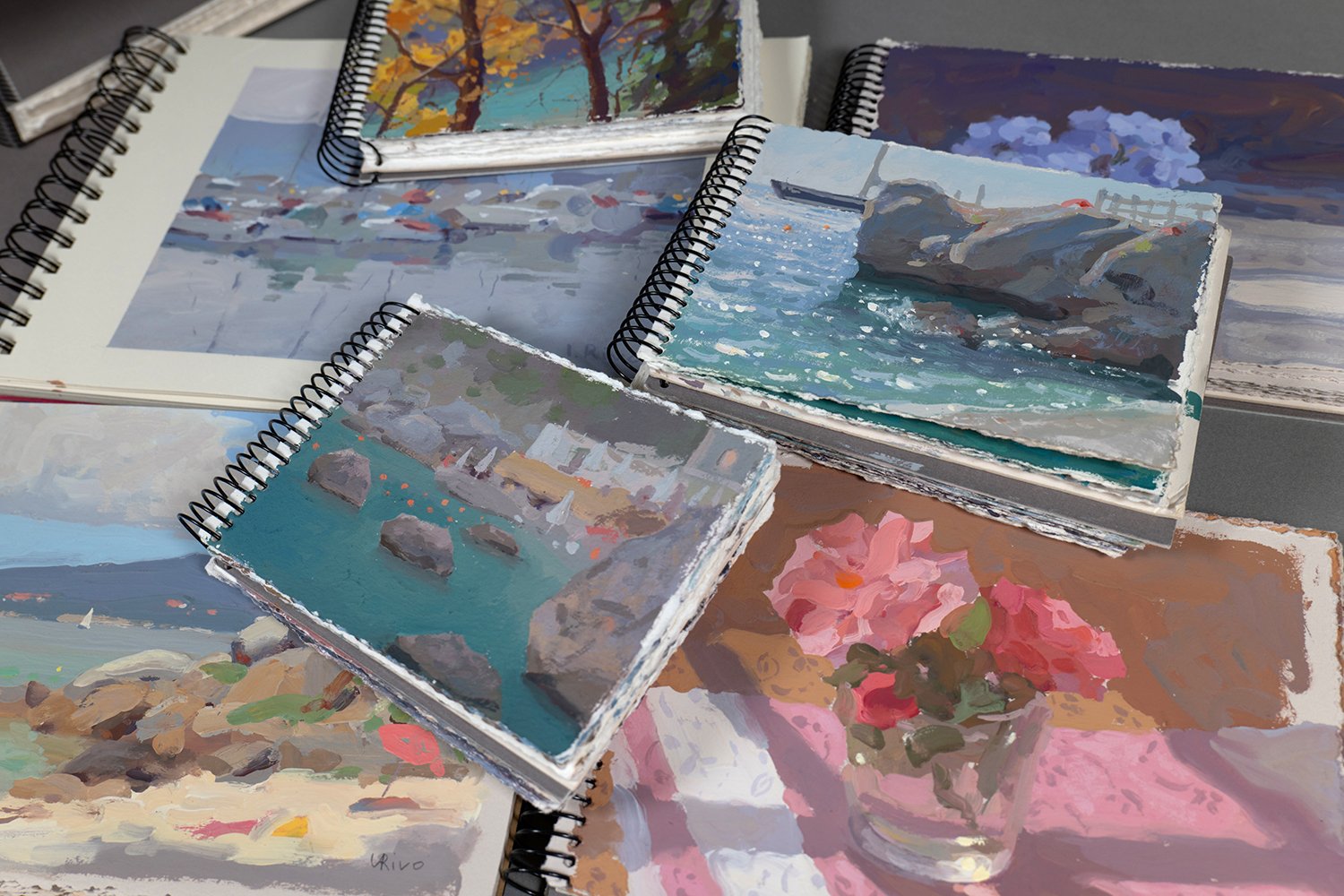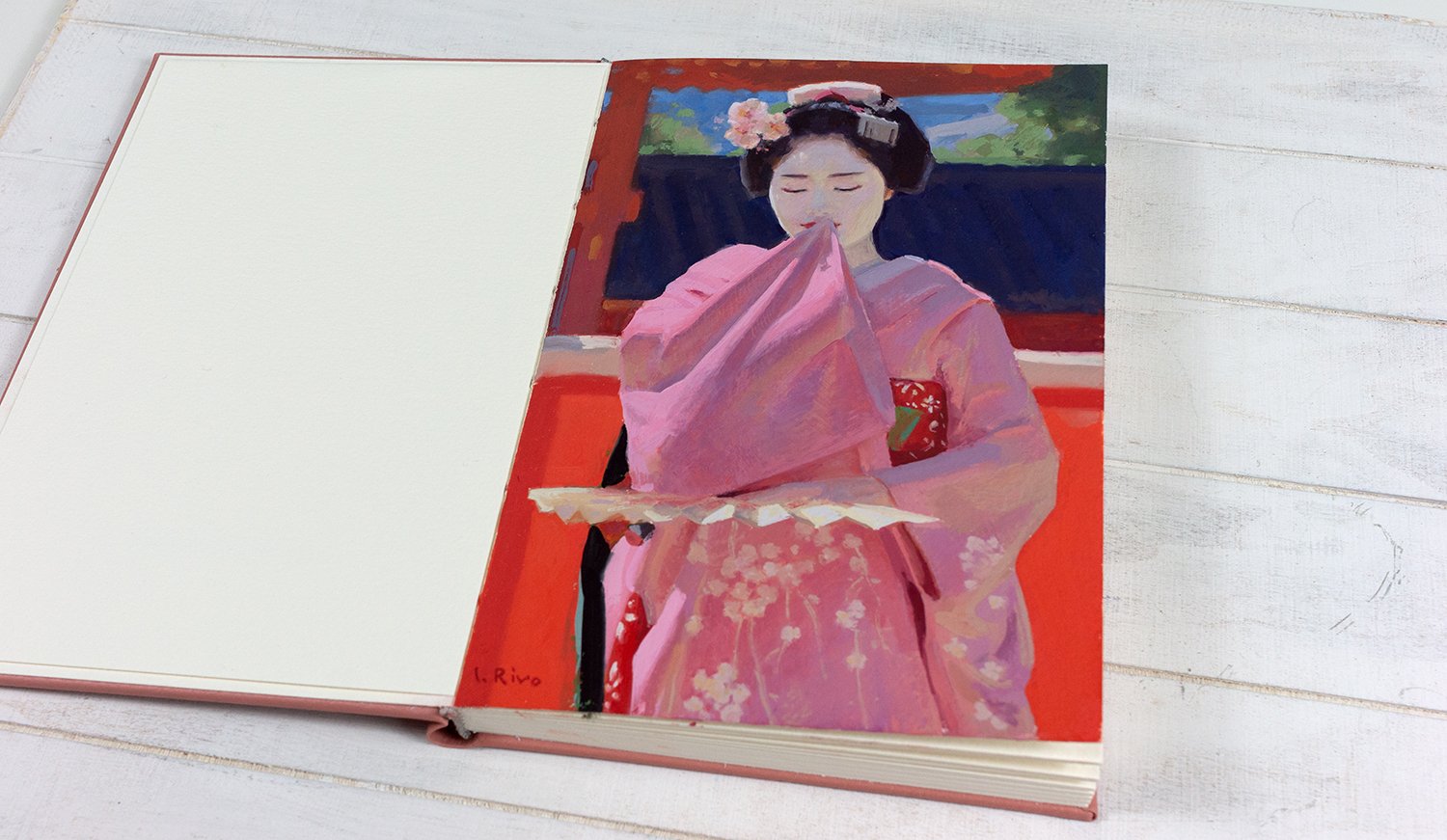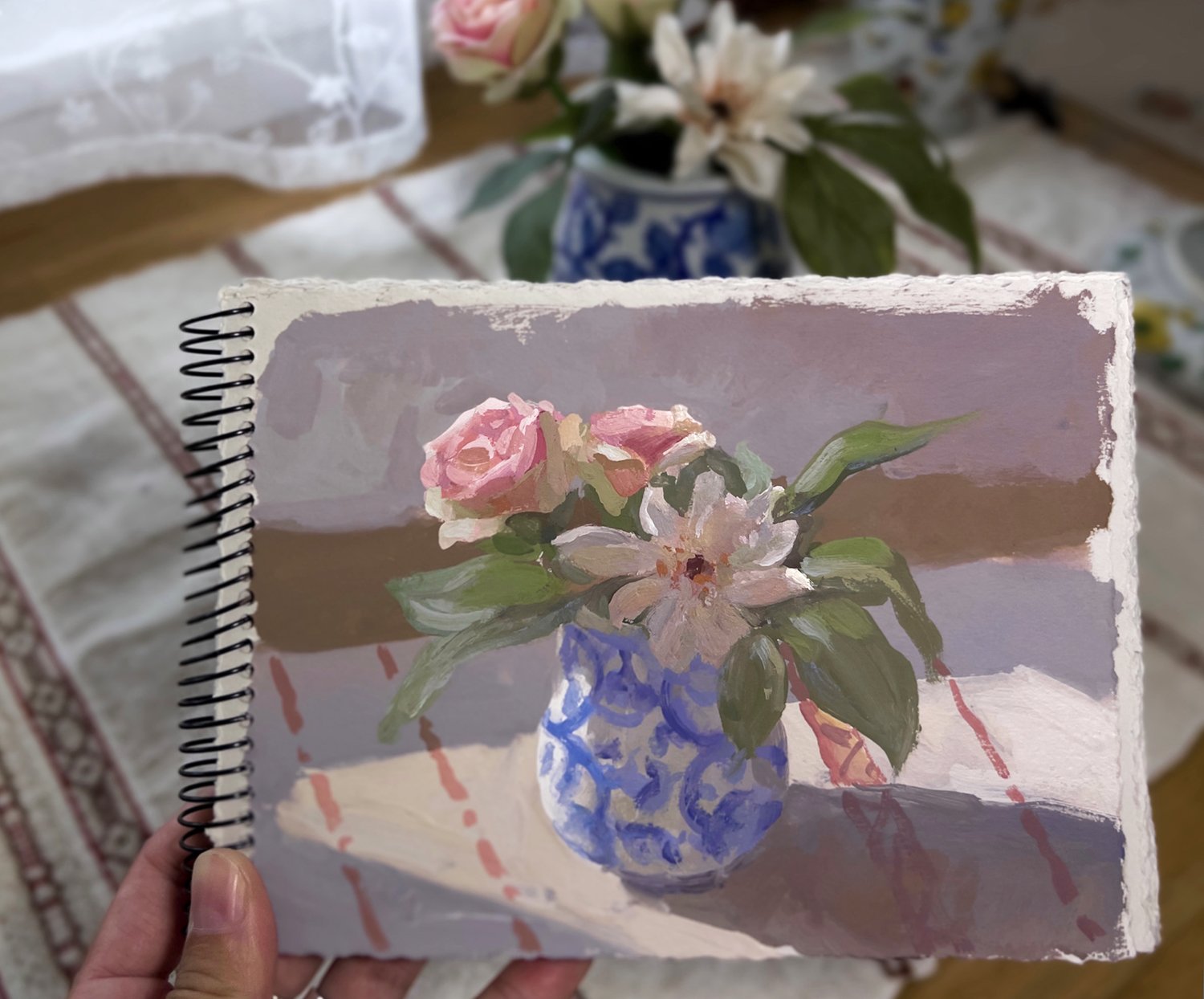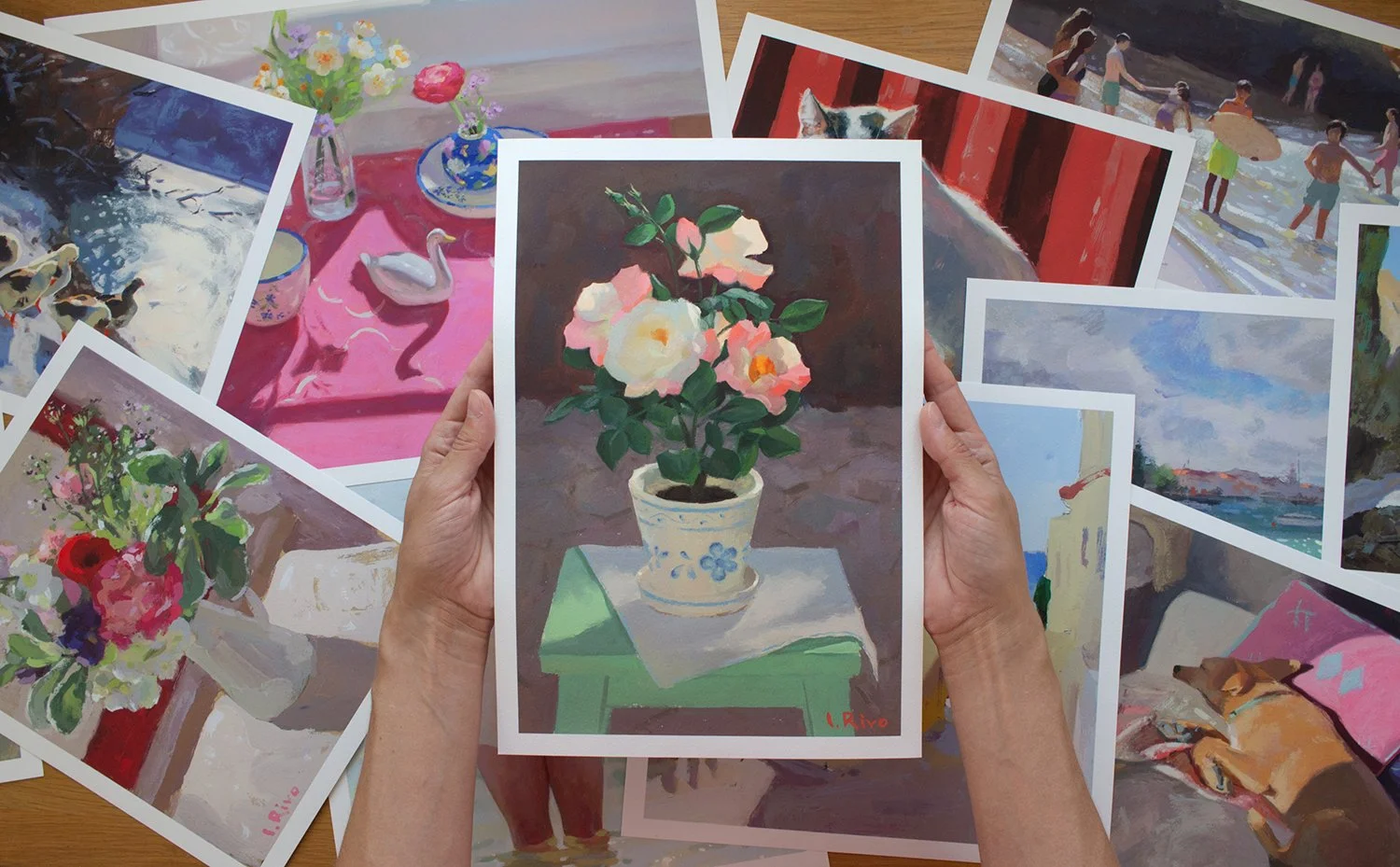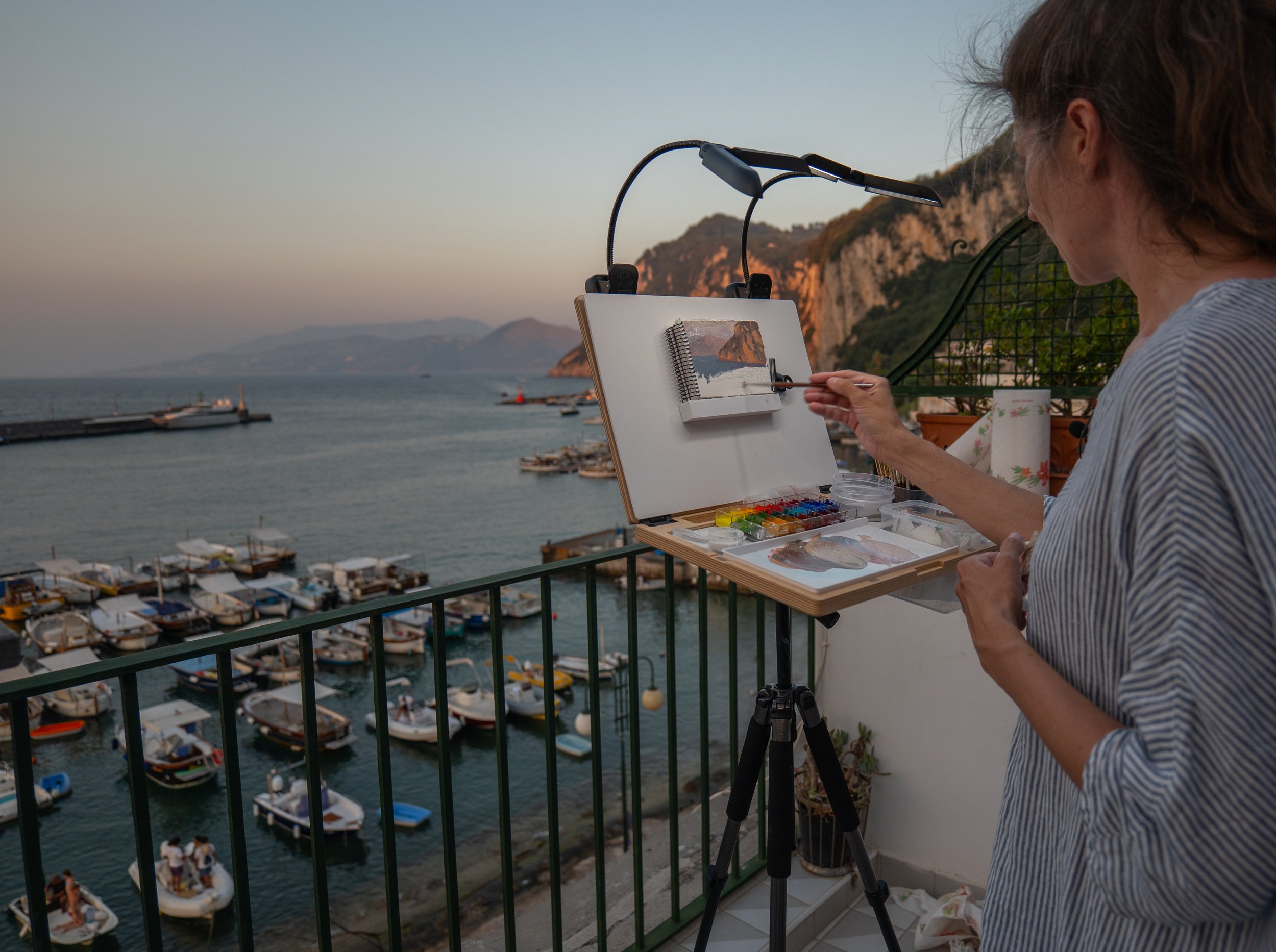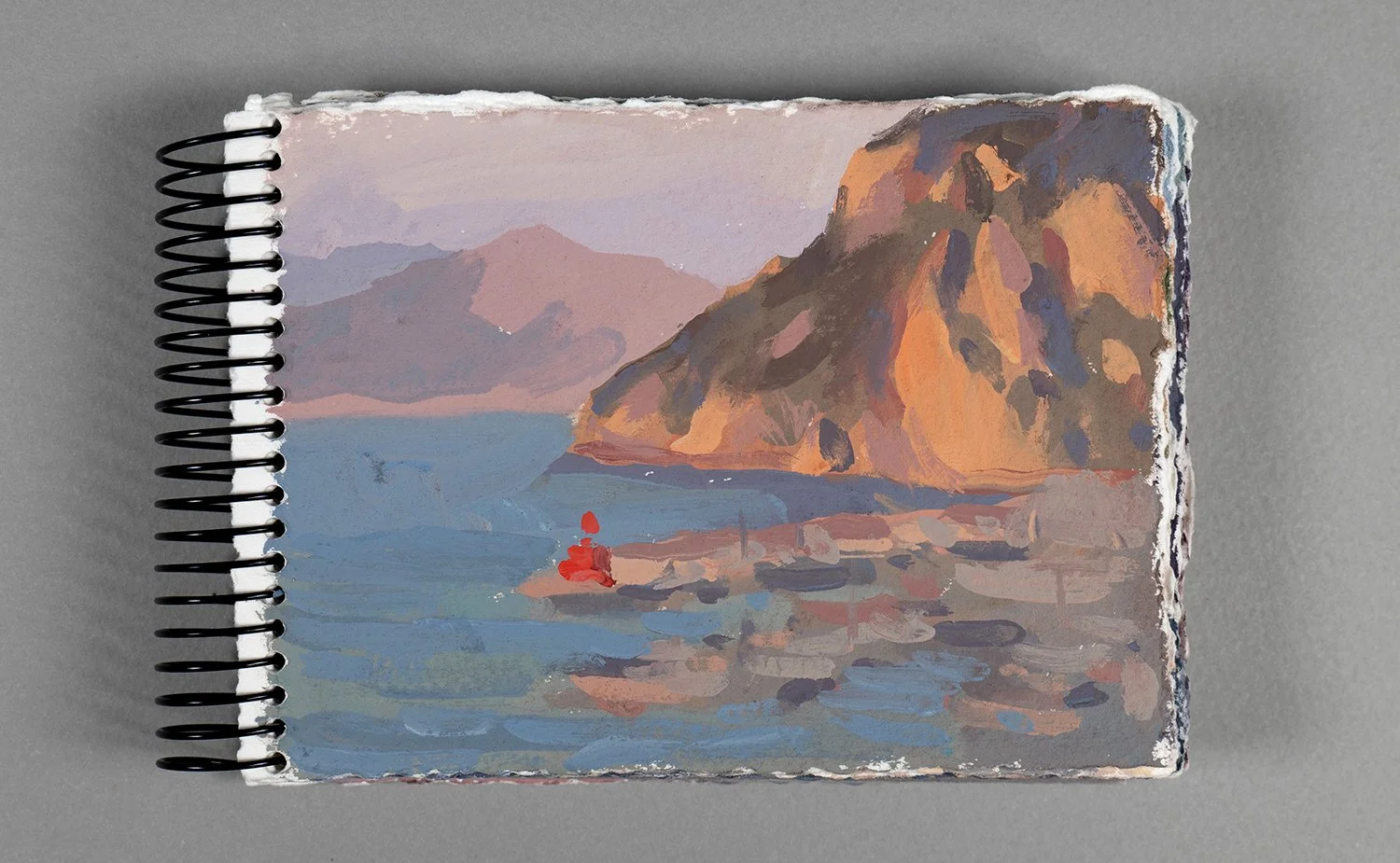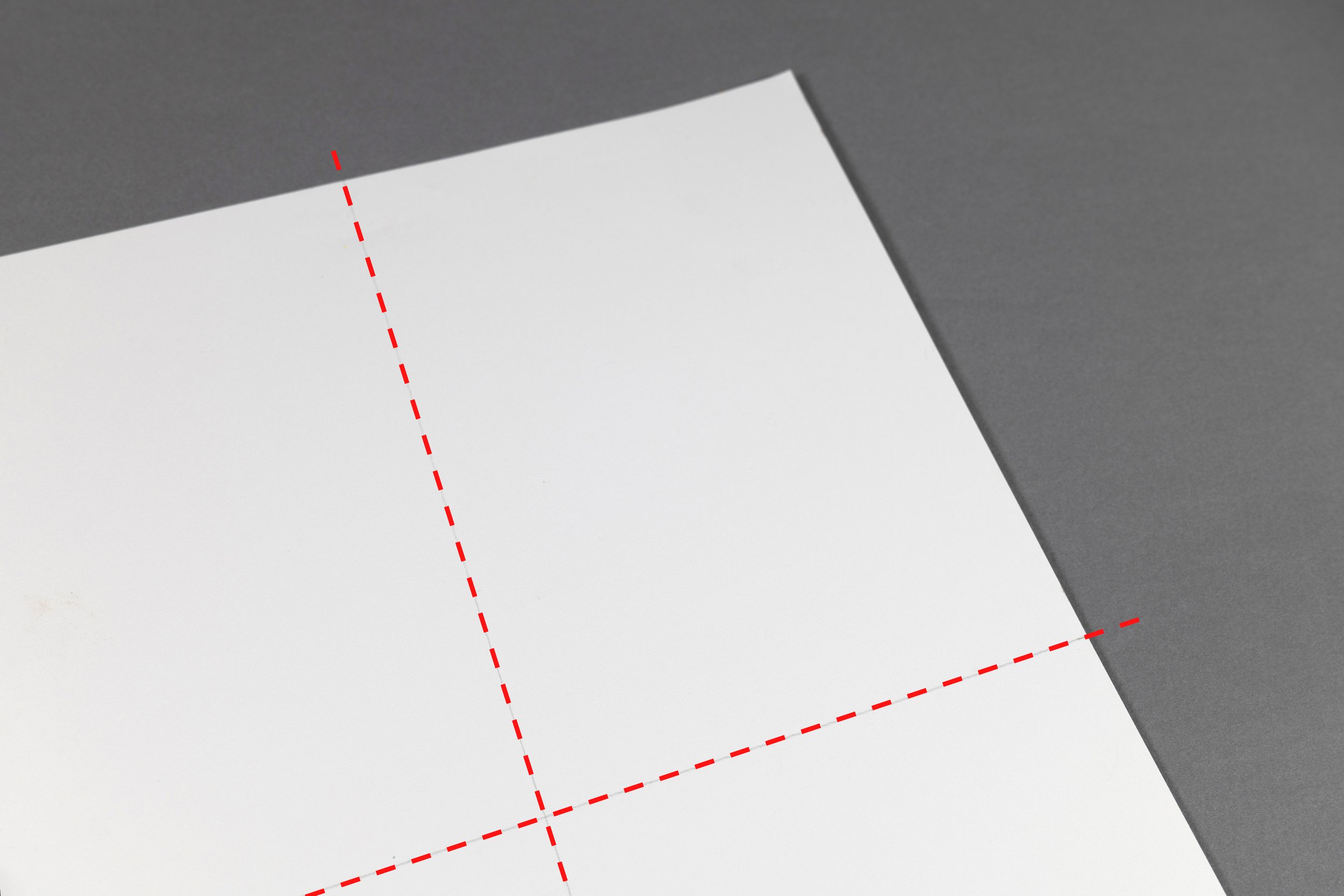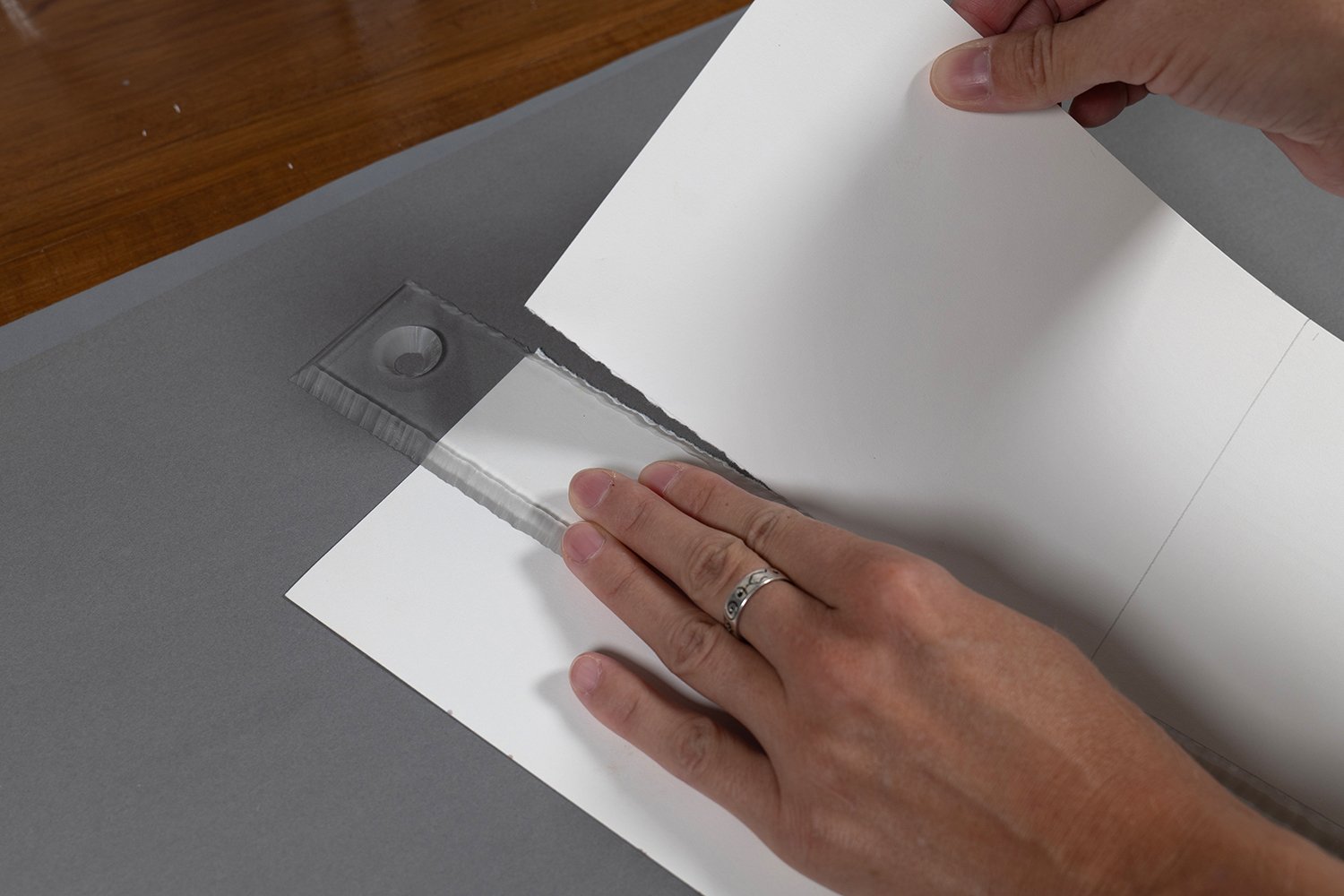The Painting Process - Issue Nº 10
In this series, I share the stories behind my paintings, my thought process, and the discoveries I make along the way.
※※※※
Sketchbook Painting and the Guiding Power of Excitement
I often get asked why I paint in spiral sketchbooks rather than on separate sheets of paper, which are seemingly more appropriate for selling artwork. In response, I've shared my thoughts on social media, and the resonance it found among fellow creatives has inspired me to delve deeper into the subject. I've decided to write a dedicated article about the reasons behind my choice, with the hope that my perspective might inspire others to rediscover the joy of painting.
To me, painting in a sketchbook is a very effective way to distance yourself from the notion of creating art for others. I think that the finest art emerges when you do it for yourself, for the joy of painting, expressing an idea that you have in your mind and translating it into a tangible creation - your painting.
Painting in a sketchbook encourages a relaxed state of mind and allows you to treat the process as playful experimentation, free from the fear of making mistakes. It's in this atmosphere of freedom that true magic can occur, opening the door to creating something genuinely extraordinary.
Creating art with the primary goal of selling can limit your creativity and promote a fear of error, yet making and correcting mistakes is fundamental for artistic growth.
It is always great when your artwork finds a buyer. While sales may not guarantee a steady income, they always offer motivation. Our art is an expression of who we are, and every artwork we sell serves as encouragement to continue to express our inner world with our favorite medium.
However, authenticity is crucial in art. Art should mirror the artist's essence. If our focus shifts too heavily towards selling, there's a risk of deviating from this fundamental purpose and losing sight of the initial inspiration that led us to pick up a brush in the first place.
When you select your painting subjects with the question, 'Will this sell?' you can inadvertently close the door to your inner world and begin to rely on external influences for guidance. I've been in that mindset, and it's a familiar place. You find yourself dissecting market trends, comparing one artist's success to another, and gauging which paintings get the most likes, all in the pursuit of understanding how to craft something that will attract a larger audience.
Frankly, that sales-first approach has never worked well for me. Years back, I made an intriguing observation: paintings born from personal experimentation, no matter how small or sketchy, consistently found buyers more quickly than the finished paintings I created with the idea of selling them.
It dawned on me that perhaps people could sense the energy and delight I put into those spontaneous studies, and that realization marked a significant turning point in my artistic journey.
Since then, I have developed a specific approach to choosing my subjects, surfaces, and mediums for painting.
Whether immersed in the beauty of a physical location or browsing through a collection of photographs on my computer, my process for selecting painting subjects is guided by excitement and inspiration.
Sometimes, while considering different scenes, I might think, 'Hmm, that could make for a nice painting,' and then, 'Oh, this one has potential, too,' but it’s when I encounter a scene that truly captivates me that I can say, 'Wow! What a beautiful contrast! I must paint this!' At that moment, a rush of energy enlivens me, and the thrill of capturing that subject becomes irresistible. It's that intense excitement, a visceral feeling that transcends words, which becomes my guiding beacon. It's as if an inner voice insists I express something significant through my art, and that, for me, is the essence of my creative process now.
That’s also why I use gouache. People often ask me about my preference for gouache. I could list many reasons, but simply put, gouache brings me joy. It took me a while to realize that it was all that mattered. When I started using gouache, I was encouraged to stick with oil painting because oil was considered the medium for 'serious' artists. And for a while, I followed that advice. However, I soon came to realize that gouache was the only medium that called me back time and again, purely for the sheer pleasure of painting. I was happiest when I was working with gouache, and when I fully embraced that realization, I made gouache my primary medium.
My excitement often guides my choice of painting supports. The tactile sensation of a quality sketchbook, the texture of soft paper, or the surface of a smooth clay board can spark a compelling urge to create. That initial impulse is usually all I need.
The subject I choose to depict becomes secondary. What matters is the joy and enthusiasm I bring to the work. It's about an exchange of energy, and when that energy is positive, it's more likely to resonate with others.
Everything that sparks your curiosity and imagination is worth exploring and should never be ignored.
I really like what Rick Rubin said about making art: “What makes it great is the personal… with all its imperfections, with all its quirkiness. That’s what makes it great. How you see the world… that’s different from how everyone else sees the world. That’s why you are an artist. That’s the purpose in sharing your work with the world. We are not smart enough to know what someone else is gonna like… Do what’s personal to you. Take it as far as you can go. Really push the boundaries. Be in this flow of catching these waves through the doing.”
Prioritizing your feelings may appear impractical to the pragmatic mind, but it's an experiment well worth undertaking. It's about trusting your feelings for a while and observing the results. When you begin to follow your excitement, not only in your artistic endeavors but also in other aspects of life, you'll notice a transformative shift, and support will often come from unexpected places. Embracing a playful mindset always unlocks new opportunities.
Mental freedom is essential for a creative person. While we all want to sell our artwork, it's essential to find ways to periodically set aside commercial considerations and allow ourselves to become immersed in our excitement and simply enjoy the creative process.
While I often create larger paintings on individual sheets of paper or boards, there are moments when I just want to play without any mental restrictions, and that's when small sketchbooks become my perfect canvas. Exploring ideas on a smaller scale is often more enjoyable and less daunting, and you can always translate your favorite studies into larger paintings if desired.
I usually paint on only one side of a page to keep the option of selling my studies and sketches open. I've successfully sold many pieces from my sketchbooks. Since all my gouache works are matted to conceal the paper edges, it doesn't matter if they are on sketchbook pages.
Sketchbook studies can be scanned and transformed into fine art prints at significantly larger sizes. Many of my prints originate from small paintings made for the sheer pleasure of painting, without any initial intention to sell them.
Giclee prints.
The practicality of small sketchbooks is invaluable for "plein air" painting. Years of experience have taught me that outdoor conditions are ever-changing — the sun's position continually shifts, altering colors and values, clouds drift, and unexpected events often occur. These factors can change a scene within moments. Often, there's limited time to accurately capture the fleeting qualities that inspired me to paint, and small sketchbooks provide the perfect solution for such swift and precise work.
When painting outdoors, I either aim to quickly capture a fleeting natural event such as the glimmer of light on water or the setting sun, or to paint a daytime scene under more consistent lighting conditions.
In situations with stable, long-lasting lighting, you might have a couple of hours to create a detailed study. However, short-lived conditions can range from a few minutes to half an hour, demanding maximum painting speed, keen attention, and swift reactions. That's when I turn to my smallest sketchbooks.
When the scene transforms with every passing minute, there's no time to cover a large canvas. You need to mix and apply paint rapidly to capture the colors and values of the main shapes as accurately as you can. It makes small sketchbooks the ideal tool for capturing ephemeral moments in the outdoors.
A 15-minute "plein air" study.
Once, someone asked me, "Isn't it just an interpretation? Why bother about precise colors and values?" My goal when painting on location isn't merely to offer an interpretation of what's before me. Instead, I always strive to paint my subject as true-to-life as possible so that when I look at my study at home, I can see and feel exactly what I saw and felt when I was painting it.
In my perspective, adopting an impressionistic style is not about freely interpreting your subject, but rather, it’s an attempt to capture with paints the splendid beauty of a moment as you experienced it so that when you hang your painting on a wall, it becomes a window offering a glimpse into that unique moment.
Painting on a small scale helps you concentrate on the color-value relationships of the main shapes that make up your subject and block them in quickly without being caught up in detail or losing precious time on filling a large canvas with paint. Simplifying your subject and interpreting it into a set of simple shapes with the right color-value relationships is the most challenging aspect of the painting process, especially when working from life. So, it makes sense to tackle this stage on a smaller scale initially and later translate that study onto a larger canvas, if necessary.
These are my reasons for using sketchbooks and small formats. I believe there's a lot of room for personal and professional growth in these practices.
In the following section, I would like to share some information about the sketchbooks I make.
I have used different kinds of sketchbooks, but spiral-bound ones have been my favorite. With them, I can flip the used pages back and position the sketchbook on my easel much like a paper block or a canvas.
Unfortunately, the market offers limited options for spiral sketchbooks with quality watercolor paper. Therefore, I started making my own sketchbooks using various types of paper.
For more abstract paintings, like the one shown below, I prefer working with cold-pressed watercolor paper. Its slightly textured and absorbent surface allows me to soften edges and create smooth color gradations easily.
A 15-minute "plein air" study.
For more detailed studies that involve subjects like boats and people, for example, I prefer sketchbooks with smoother, hot-pressed paper which allows for more delicate brushstrokes. Also, being less absorbent, it makes painting with gouache easier and faster, so I often choose smooth paper when I paint from life. My preferred paper weight typically ranges from 240 gsm to 640 gsm.
From a single 30” x 22” sheet of paper, you can make an 18-page 5” x 7” sketchbook.
I really like painting on pages with deckled edges. Therefore, I use a deckle edge ruler (like this one https://amzn.to/3tUkXUV) to tear the paper sheets into the sizes I desire.
Keep in mind that heavy-weight papers can be challenging to tear. When I tear 640 gms paper, my hands can ache the next day, so if you want to avoid that, you should use lighter paper. The most popular 340 gsm watercolor paper tears much easier and is heavy enough to use with gouache.
The process of creating spiral sketchbooks is quite straightforward.
1. I begin by drawing a grid with 5x7 inch rectangles on a sheet of paper.
2. Next, I carefully tear the paper along those lines using the deckle edge ruler.
3. For the covers and backs of my sketchbooks, I use leftover mat boards which I cut with a utility knife.
4. Lastly, I bring the pages and covers to a local copy shop, where they are spiral-bound.
Making your own sketchbooks is fun. It allows you to experiment with various types of paper and sketchbook sizes to discover what works best for you.
Thank you for reading! I hope you found it helpful.
Happy painting!
Lena
Download my free 30-page PDF, “Everything you Need To Know About Gouache”
In this 30-page PDF you will learn:
How to decide which colors you need when you start with gouache and how you can expand your palette to make it even more effective.
What kind of storage palettes to use with gouache to prevent your beautiful colors from fast drying.
Why you need to use two whites with gouache.
How to choose the right paper and what kinds of brushes work best with gouache.
About the setup that I like using for plein air painting with gouache.
You will also be provided with many useful tips that will make your painting experience smoother.


